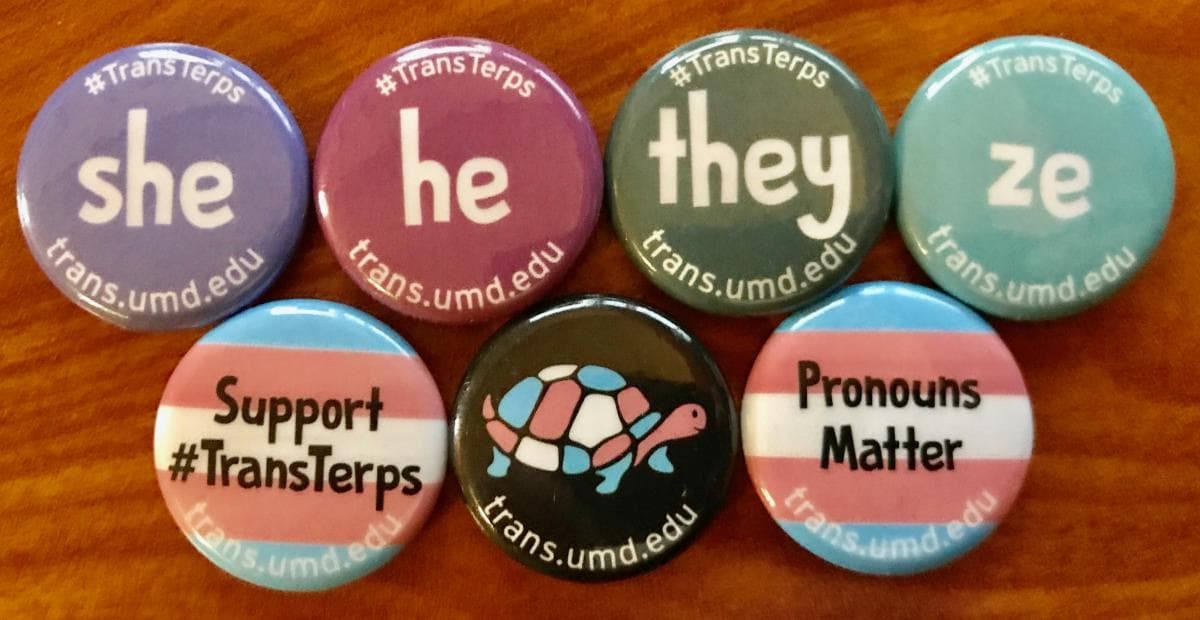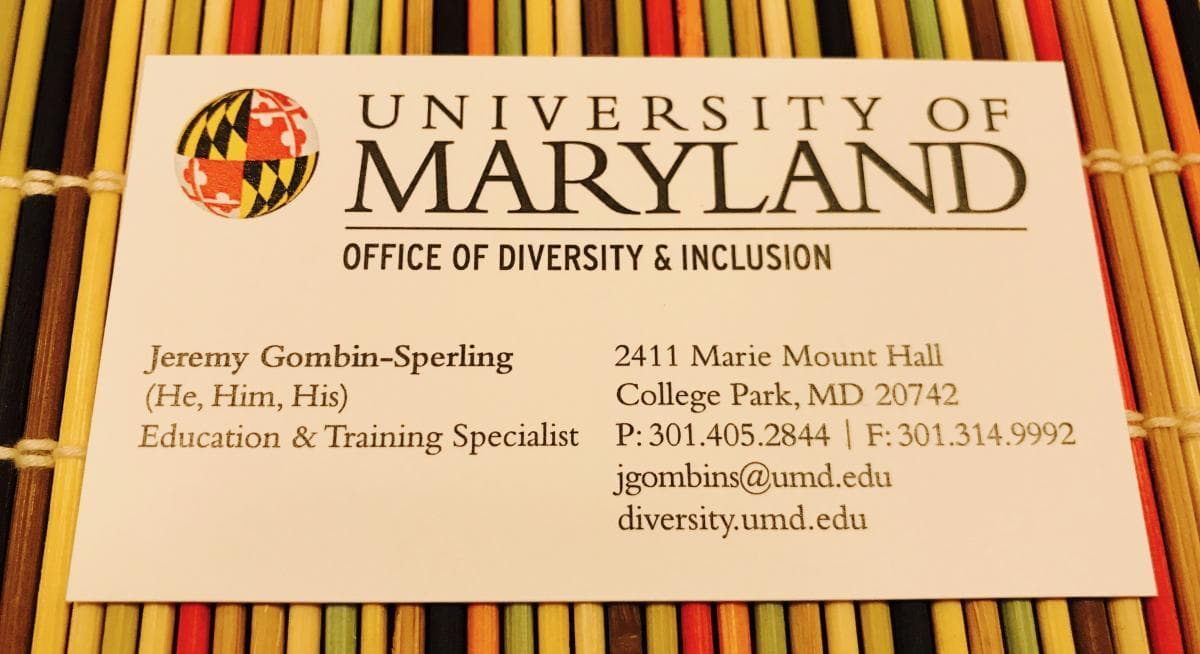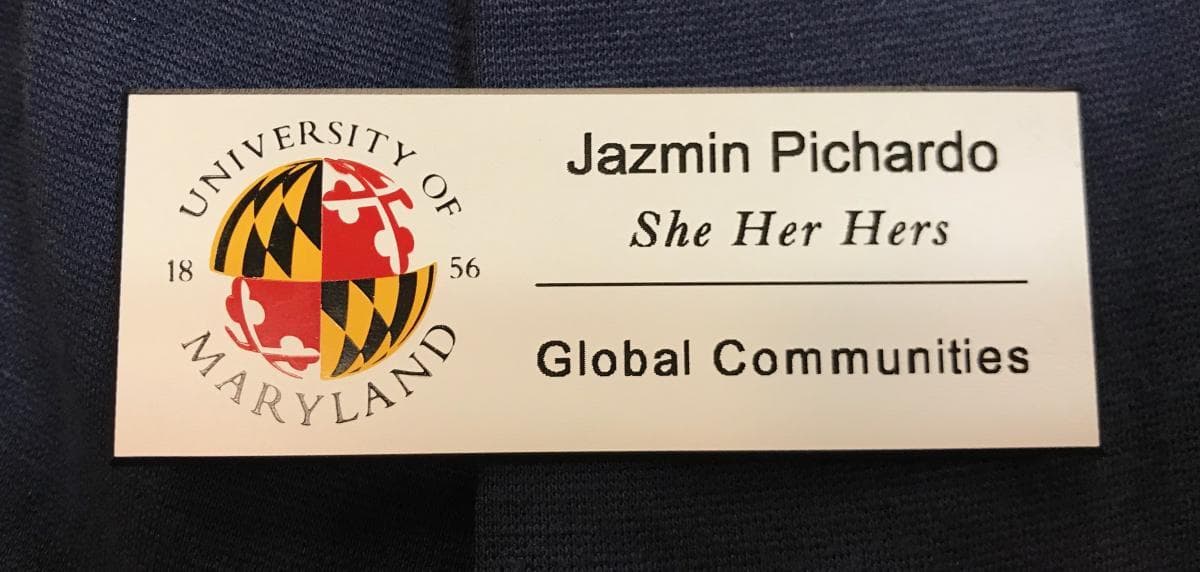Good Practices: Names and Pronouns

As with good practices generally, any advice must be combined with a specific context and use of good judgement in order to determine what is appropriate to a specific situation. This page is part of the broader #TransTerps campaign, and on this site you can find out more about trainings and resources and policies for supporting trans folks on campus.
This page has information about good practices for trans inclusion around names and pronouns. Specifically, you can find information about:
- Learning About Pronouns
- Business Cards, Email Signatures, and Name Badges
- Example Syllabus or Handbook Language
Learning About Pronouns
The #TransTerps project is distributing materials around campus, including pronouns buttons and business cards with information about pronouns. Your office or group can sign on to the campaign and request materials. You can also learn more about pronouns through some of our trainings and events.
If you would like to learn even more about pronouns, one great website is MyPronouns.org, where you can find detailed examples and information about pronouns and how to use them, what to do if you make a mistake, how to share your pronouns, how to invite people to share their pronouns, and additional resources.
Business Cards, Email Signatures, and Name Badges
Please see the trans policies and resources page if you would like to update your name or gender marker in university records.
We encourage more people to include the pronouns they wish to be referred to by in prominent places where their name appears for the first time. For example, in a written biography or staff page of a website, on business cards, in an email signature, on permanent office name badges or office name plates, and on conference or event name tags.
Forthcoming, there will be a way to order UMD business cards with
pronouns on them through a drop-down option, without making a special
request. A link to that will be made available here when it becomes
available. In the meantime, you can add your pronouns by request.




Example Syllabus or Handbook Language
If you teach classes or manage an office's handbook or manual, you might consider inserting information about names and pronouns. Here are some examples:
Full Version
Forms of Address: Names and Pronouns
Our institution's official policy states that "The University of Maryland recognizes that name and gender identity are central to most individuals' sense of self and well-being, and that it is important for the University to establish mechanisms to acknowledge and support individuals' self-identification." One way we can support self-identification is by honoring the name and pronouns that each of us go by.
Many people (e.g. international students, performers/writers, trans people, and others) might go by a name in daily life that is different from their legal name. In this classroom, we seek to refer to people by the names that they go by.
Pronouns can be a way to affirm someone's gender identity, but they can also be unrelated to a person's identity. They are simply a public way in which people are referred to in place of their name (e.g. "he" or "she" or "they" or "ze" or something else). In this classroom, you are invited (if you want to) to share what pronouns you go by, and we seek to refer to people using the pronouns that they share. The pronouns someone indicates are not necessarily indicative of their gender identity.
Visit trans.umd.edu to learn more.
Condensed Version
Names and Pronouns: Many people might go by a name in daily life that is different from their legal name. In this classroom, we seek to refer to people by the names that they go by. Pronouns can be a way to affirm someone's gender identity, but they can also be unrelated to a person's identity. They are simply a public way in which people are referred to in place of their name (e.g. "he" or "she" or "they" or "ze" or something else). In this classroom, you are invited (if you want to) to share what pronouns you go by, and we seek to refer to people using the pronouns that they share. The pronouns someone indicates are not necessarily indicative of their gender identity. Visit trans.umd.edu to learn more.
Simple Version
Names and Pronouns: In this classroom, we will respect and refer to people using the names and personal pronouns that they share. Visit trans.umd.edu to learn more.
Broader Statement on Identities
Names/Pronouns and Self Identifications
The University of Maryland recognizes the importance of a diverse student body, and we are committed to fostering equitable classroom environments. I invite you, if you wish, to tell us how you want to be referred to both in terms of your name and your pronouns (he/him, she/her, they/them, etc.). The pronouns someone indicates are not necessarily indicative of their gender identity. Visit trans.umd.edu to learn more.
Additionally, how you identify in terms of your gender, race, class, sexuality, religion, and dis/ability, among all aspects of your identity, is your choice whether to disclose (e.g. should it come up in classroom conversation about our experiences and perspectives) and should be self-identified, not presumed or imposed.
I will do my best to address and refer to all students accordingly and will support you in doing so as well.